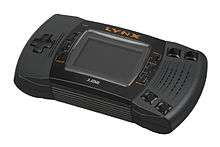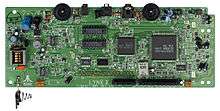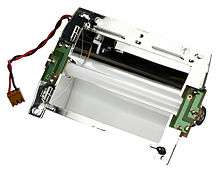Atari Lynx
|
| |
|
Atari Lynx I | |
| Developer |
Epyx Atari Corporation |
|---|---|
| Manufacturer | Atari Corporation |
| Type | Handheld game console |
| Generation | Fourth generation |
| Release date | September 1, 1989 |
| Retail availability | 1989–1995 |
| Introductory price | US$179.99[1] |
| Units sold | Around 3 million |
| Media | ROM cartridge |
| CPU | WDC 65SC02 |
| Display | 160 × 102 standard resolution (16,320 addressable pixels) |
| Online services |
Comlynx (18-player networking) |
The Atari Lynx is a 16-bit handheld game console that was released by Atari Corporation in September 1989 in North America, and in Europe and Japan in 1990. The Lynx holds the distinction of being the world's first handheld electronic game with a color LCD. The system is also notable for its forward-looking features, advanced graphics, and ambidextrous layout. The Lynx competed with the Game Boy (released just 2 months earlier), as well as the Game Gear and TurboExpress, both released the following year. It was discontinued in 1995.
Features
The Atari Lynx's innovative features include being the first color handheld, with a backlit display, a switchable right-handed/left-handed (upside down) configuration, and the ability to network with up to 15 other units via its "Comlynx" system (though most games would network eight or fewer players). Comlynx was originally developed to run over infrared links (and was codenamed RedEye). This was changed to a cable-based networking system before the final release.
Dave Needle, Lynx codesigner[2]
The Lynx was cited as the "first gaming console with hardware support for zooming and distortion of sprites". Featuring a 4096 color palette and integrated math and graphics co-processors (including a blitter unit), its pseudo-3D color graphics display was said to be the key defining feature in the system's competition against Nintendo's monochromatic Game Boy. The fast pseudo-3D graphics features were made possible on a minimal hardware system by co-designer Dave Needle having "invented the technique for planar expansion/shrinking capability" and using stretched, textured, triangles instead of full polygons.[2] These particular features were achieved over a year prior to the launch of the Super NES, whose stock hardware features the comparable Mode 7 but which cannot scale sprites.
History
The Lynx was the second handheld game system to be released with the Atari name. The first was Atari Inc.'s handheld electronic game Touch Me. Atari Inc. had previously worked on several other handheld projects including the Breakout, Space Invaders, and the Atari Cosmos portable/tabletop console. However, those projects were shut down during development, some just short of their intended commercial release.
The Lynx system was originally developed by Epyx as the Handy Game. In 1986, two former Amiga designers, R. J. Mical and Dave Needle, had been asked by former manager at Amiga, David Morse, if they could come up with a design for a portable gaming system.[3][4] Morse now worked at Epyx, a game software company that had a recent string of hit games. Morse's son had asked him if he could make a portable gaming system, prompting the lunch with Mical and Needle to discuss the idea. Morse convinced Mical and Needle to develop the idea and they were hired by Epyx to be a part of the design team.[3] Planning and design of the console began in 1986 and was completed in 1987.[5] Epyx first showed the Handy system at the Winter Consumer Electronics Show (CES) in January 1989.[3] Facing financial difficulties, Epyx sought out partners. Nintendo, Sega, and other companies declined, but Atari Corp. and Epyx eventually agreed that Atari Corp. would handle production and marketing, while Epyx would handle software development. Epyx declared bankruptcy by the end of the year, and Atari essentially owned the entire project; both Atari and others, however, had to purchase Amigas from Atari archrival Commodore to develop Lynx software.[6]
The Handy was designed to run games from the cartridge format, and the game data must be copied from ROM to RAM before it can be used. Thus, less RAM is available and the games initially load relatively slowly.[7] There are trace remnants of a cassette tape interface physically capable of being programmed to read a tape. Lynx developers have noted that "there is still reference of the tape and some hardware addresses"[8] and an updated vintage Epyx manual describes the bare existence of what could be utilized for tape support.[9]:ch.2,8 A 2009 retrospective interview clarifies that although some early reports claimed that games were loaded from tape, Mical says there was no truth in them: "We did think about hard disk a little".[2]
Atari Corp. changed the internal speaker and removed the thumb-stick on the control pad before releasing it as the Lynx, initially retailing in the US at US$179.95. Atari Corp. then showed the Lynx to the press at the Summer 1989 CES as the "Portable Color Entertainment System", which was changed to "Lynx" when actual consoles were distributed to resellers.[7]
The Lynx started off successfully. Atari reported that they had sold 90% of the 50,000 units it shipped in its launch month in the U.S. with a limited launch in New York.[10] US sales in 1990 were approximately 500,000 units according to the Associated Press.[11] In late 1991, it was reported that Atari sales estimates were about 800,000, which Atari claimed was within their expected projections.[12] Lifetime sales by 1995 amounted to fewer than 7 million units when combined with the Game Gear.[13] In comparison, the Game Boy sold 16 million units by 1995[13] because it was more rugged, cost half as much, had much longer battery life, was bundled with Tetris, and had a superior software library.[6] In issue 129 of Retro Gamer magazine, a special article was published to celebrate the 25th anniversary of the console which included interviews with numerous ex-Atari and ex-Epyx staff where lifetime Lynx sales figures were confirmed as being in the region of 3 million.
As with the actual console units, the game cartridges themselves evolved over the first year of the console's release. The first generation of cartridges were flat, and were designed to be stackable for ease of storage. However, this design proved to be very difficult to remove from the console and was replaced by a second design. This style, called "tabbed" or "ridged", used the same basic design as the original cartridges with the addition of two small tabs on the cartridge's underside to aid in removal. The original flat style cartridges could be stacked on top of the newer cartridges, but the newer cartridges could not be easily stacked on each other, nor were they stored easily. Thus a third style, the "curved lip" style was produced, and all official and third-party cartridges during the console's lifespan were released (or re-released) using this style.[14]
In May 1991, Sega launched its Game Gear portable gaming handheld. Also a color handheld, in comparison to the Lynx it had a higher cost and shorter battery life (3–4 hours as opposed to 4-5 for the Lynx), but it was slightly smaller and was backed up by significantly more games. In North America the Game Gear took second place, and while in Europe sales of the Lynx were initially quite strong on the back of the popular Atari ST, it still could not compete with the software library of the Game Gear and was eventually pushed into third place. Retailers such as Game and Toys R Us continued to sell the Lynx well into the mid-1990s on the back of the Atari Jaguar launch, helped by magazines such as Ultimate Future Games who continued to cover the Lynx alongside the new generation of 32-bit and 64-bit consoles.
Lynx II

During 1990, the Lynx had moderate sales. In July 1991, Atari Corp. introduced the Lynx II with a new marketing campaign, new packaging, slightly improved hardware, better battery life and a new sleeker look. The new system (referred to within Atari Corp. as the "Lynx II") featured rubber hand grips and a clearer backlit color screen with a power save option (which turned off the LCD panel's backlighting). It also replaced the monaural headphone jack of the original Lynx with one wired for stereo. The new packaging made the Lynx available without any accessories, dropping the price to $99. Although sales improved, Nintendo still dominated the handheld market.
In 1995, Atari Corp. shifted its focus away from the Lynx. As the Super NES and Genesis filled retailers' shelves, Atari Corp. refocused its efforts on its Jaguar console and its CD-ROM add-on. A handful of games were released during this time, including Battlezone 2000. In 1996, Atari shut down its internal game development.
Reception
The game system was reviewed in 1990 in Dragon, giving the Lynx 5 out of 5 stars. The review states that the Lynx "throws the Gameboy [sic] into the prehistoric age"; and praises the built-in object scaling capabilities, the multiplayer feature of the ComLynx cable, and the strong set of launch games.[15]
The infrequency of Lynx software releases and the system's minimal marketing budget have been cited as the main factors in its commercial failure.[16]
After Atari
Telegames released a number of games in the second half of the 1990s, including a port of Raiden and a platformer called Fat Bobby in 1997, as well as an action sports game called Hyperdrome in 1999. At the end of the 1990s, Hasbro, the owners of the Atari properties at the time, released the rights to develop for the system to the public domain. Since then a number of independent developers released games into the new decade, like Championship Rally, CyberVirus, and Alpine Games.[17] Some of the late 1990s/early 2000s games were under development by other companies at one time, but rights to the game programs and all of the existing code was bought and finished by other developers.[18]
In 2008 Atari was honored at the 59th Annual Technology & Engineering Emmy Awards for pioneering the development of handheld games with its Lynx game unit.[19]
On October 24, 2009, North American company Super Fighter Team released Zaku, a horizontal shooter for the Lynx developed by PenguiNet. It was the first new game for the system since the 1990s whose game card has an authentic "curved lip" plastic shell instead of a custom bare circuit board.[20] Three other non-prototype Lynx game have been developed by the retrogaming community.[21]
Technical specifications


- Mikey (16-bit custom CMOS chip running at 16 MHz)[22]
- WDC 65SC02 processor running at up to 4 MHz (~3.6 MHz average)[3]
- 8-bit CPU, 16-bit address space
- Based on MOS 6502
- Sound engine
- 4 channel sound (Lynx II with panning)
- 8-bit DAC for each channel (4 channels × 8-bits/channel = 32 bits commonly quoted) these 4 soundchannels can also switch in tripple analogue sound modus to generate sound effects similar to FM & PSG sound, Atari reports the range is "100Hz to above the range of human hearing"; spectrum analysis shows the range may go as low as 32 Hz.
- Stereo with panning (mono for original Lynx)
- Video DMA driver for liquid-crystal display
- 160×102 pixels resolution (16320 pixels; 102 is the maximum number of 160-pixel scan lines that yields a pixel count no higher than 16×210=16384, compare [[Color Graphics Alltrough 480x102 resolution is possible in monochrome modus. Adapter#160×100 16 color mode|CGA 160×102]])
- 4,096 color (12-bit) palette
- 16 simultaneous colors (4 bits) from palette per scanline (more than 16 colors can be displayed by changing palettes after each scanline)
- Miscellaneous components
- System timers
- Interrupt controller
- UART (for ComLynx)
- 512 bytes of bootstrap and game-card loading ROM
- WDC 65SC02 processor running at up to 4 MHz (~3.6 MHz average)[3]
- Suzy (16-bit custom CMOS chip running at 16 MHz)
- Blitter unit
- Bit-map block transfer unit
- Graphics engine
- Hardware drawing support
- Unlimited number of high-speed blitter "sprites" with collision detection
- Hardware high-speed sprite scaling, distortion, and tilting effects
- Hardware decoding of compressed sprite data
- Hardware clipping and multi-directional scrolling
- Variable frame rate (up to 75 frames/second)
- 160 × 102 standard resolution (16,320 addressable pixels)
- Math co-processor
- Hardware 16-bit × 16-bit → 32-bit multiply with optional accumulation; 32-bit ÷ 16-bit → 16-bit divide
- Parallel processing of CPU and a single multiply or a divide instruction
- Blitter unit
- RAM: 64 KB 120ns DRAM
2 x 256KB Dram chips for ripping the rom from the cartridge,an audin pin can switch between those 2 256KB blocks if needed
- Storage
- Cartridge - 128, 256 and 512 KB exist, up to 2 MB is possible with bank-switching logic.
- Some (homebrew) carts with EEPROM to save hi-scores and other data.
- Other System Support
- 8 System timers (2 reserved for LCD timing, one for UART)
- Interrupt controller
- UART (for Comlynx) (fixed format 8E1, up to 62500 Bd)
- 512 bytes of bootstrap and game-card loading ROM
- Ports:
- Headphone port (3.5 mm stereo; wired for mono on the original Lynx)
- Comlynx (multiple unit communications, serial)
- LCD Screen: 3.5" diagonal
- Battery holder (six AA) ~4–5 hours (Lynx I) ~5–6 hours (Lynx II)
See also
References
- ↑ "Toys R Us weekly ad". The Catoosa County News. December 5, 1990. Retrieved June 17, 2014.
- 1 2 3 "Retroinspection: Atari Lynx". NOW Gamer. January 22, 2009. Retrieved June 18, 2014.
- 1 2 3 4 Jermaine, John (November 1989). "Lynx, an interview with the men behind the machine". Electronic Gaming Monthly. United States: Sendai Publications. Archived from the original on September 16, 2014. Retrieved June 17, 2014.
- ↑ Jacobs, Steven. "Third Time's a Charm (They Hope)". Wired. United States: Conde Nast. Retrieved June 17, 2014.
- ↑ Peter Latimer (July 2005). "Atari Lynx". Retro Gamer (4): Pages 24–31. ISSN 1742-3155.
- 1 2 Maher, Jimmy (2016-12-22). "A Time of Endings, Part 2: Epyx". The Digital Antiquarian.
- 1 2 Peter Latimer (July 2005). "Atari Lynx". Retro Gamer. 2 (6): Pages 24–31. ISSN 1742-3155.
- ↑ "Atari Lynx programming tutorial series". Diary of an Atari Lynx developer. Retrieved June 18, 2014.
- ↑ "Lynx Hardware Overview". Epyx. 1987. Retrieved June 18, 2014.
- ↑ "New games make big splash". The Nevada Daily Mail. Vernon County, Missouri. June 3, 1990. Retrieved June 17, 2014.
- ↑ Catalina Ortiz (January 4, 1991). "Sega Woos Game Boy, Lynx Users With 32-Color, Hand-Held Video System" (Press release). Associated Press. Retrieved November 7, 2013.
- ↑ "Raze Magazine" (11). September 1991: 6.
- 1 2 Steven Kent (January 5, 1995). "Virtual Fun - Nintendo Adds A New Dimension To Games". Seattle Times. Retrieved November 7, 2013.
- ↑ Atari Lynx cartridge style illustrations at AtariAge.com.
- ↑ Lesser, Hartley; Lesser, Patricia; Lesser, Kirk (March 1990). "The Role of Computers". Dragon (155): 95–101.
- ↑ "The Next Generation 1996 Lexicon A to Z: Lynx". Next Generation. No. 15. Imagine Media. March 1996. p. 36.
- ↑ Duranik. "Duranik". Retrieved February 13, 2015.
- ↑ Songbird Productions' development page for CyberVirus
- ↑ "CES '08: Nintendo wins second Emmy". GameSpot. January 8, 2008. Retrieved May 9, 2014.
- ↑ Brandon Cobb. "Zaku - www.zaku-lynx.com". Retrieved February 13, 2015.
- ↑ "Atari Age Self Published Lynx Games". atariage.com.
- ↑ "Atari Lynx FAQ". AtariAge. atariage.com. Retrieved October 24, 2014.
External links
| Wikimedia Commons has media related to Lynx (console). |
- AtariAge – Comprehensive Lynx Database and information
- Guide to Atari Lynx games at Retro Video Gamer
- Too Powerful for Its Own Good, Atari's Lynx Remains a Favorite 25 Years Later
- Atari Lynx review, 1990
